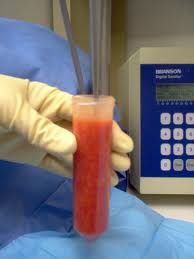Stem cells have been well known for a long time and bone marrow has been the traditional source of their harvest. Stem cells have generated such interest because medical researchers believe that stem cell therapy has the potential to dramatically change how we might treat certain the human diseases. As stem cell science has continued to evolve, new approaches are being developed about how they might be better used in medical therapies.

Concentration of liposuctioned fat is now widely available by a variety of manufacturers and their devices. This concentrated pellet of uncultured fat tissue, known as the stromal vascular fraction (SVF), is what is believed to be a potent source of stem cell therapy. Traditionally the approach to the use of stem cells has been in the context of tissue engineering. The strategy is to have the stem cells convert and grow into the missing or damaged tissue such as bone, cardiac muscle, or new brain cells or neurons. But this more easy access to uncultured SVF from liposuctioned fat has led to its potential use for healing or regenerating tissues directly rather than using a cultured differentiation of stem cells. In essence, make the body heal directly rather than implanting tissues grown outside of the body. Some refer to this as autologous regenerative therapy or ‘heal thy ownself’.
How might this work? What is the magic of stem cells that would make them heal injured tissues? Some stem cells, known as mesenchymal stem cells, live within or are attached to blood vessels. When injury occurs these blood vessels are disrupted or traumatized and some stem cells are released. This activates the stem cells which release a wide variety of chemicals, generically known as growth factors. These released factors attract the necessary cells and other elements for healing. One of its main functions is to promote new blood vessel growth which provides the highway for all healing elements to get to the site of injury In short, stem cells are a source of a new blood supply.
There are many ongoing clinical trials for stem cells which ranges from diabetes, heart attacks to spinal cord injury. In plastic surgery they include non-healing wounds and scar therapy. But of equal interest, although not a specific clinical trial, is in the improved or accelerated volume retention of injected fat grafts. Since we are injecting some level of concentrated fat aspirate, it must contain the stem cells from the disrupted blood vessels as well as those that resided in the fat itself. While this is undoubtably true, why does injected fat have such variable retention? Most likely there are not enough stem cells in our prepared fat concentrates or their amount is highly variable. But injection technique and the recipient site has a lot to do with it as well.
The stem cells in fat and in prepared injectates present interesting possibilities and potential. But we have a long way to go to understand how they may be of benefit in the plastic surgery version of the ultimate version of ‘recycling’ or ‘green surgery’.
Dr. Barry Eppley
Indianapolis, Indiana


